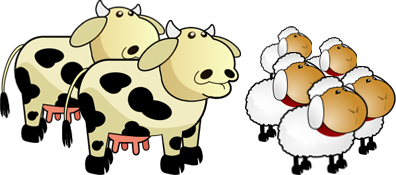Estimating farm animals
0
Overview
Using this Resource
Connecting to the Curriculum
Marking Student Responses
Working with Students
Further Resources
This task is about using a way of estimating that you have discussed with your teacher.

Daniel wanted a quick estimate of the number of animals on a farm.
Make an estimate for each of the total number of animals, and explain how you did it in the box.
Task administration:
This task is completed with pencil and paper or online.
This assessment activity is designed to be carried out with a group of students or a whole class. A suggested lesson sequence:
- Give the students the problem of estimating 437 + 286 to identify whether they use the rounding method. Students who are secure in estimation using rounding as shown in a) should perform at least one of b) or c) to confirm this, and d) which looks at rounding with numbers of a variable length.
- Discuss students' methods. Use the language of estimation for each different method.
-
Introduce the rounding strategy in addition, i.e., round each number to the nearest 10, 100, etc. You may wish to write this example down as you discuss it.
Example: Estimate 437 + 286.
i) 437 rounds to 400 and 286 rounds to 300
ii) An estimate is 400 + 300 = 700. - Students complete the sentence with the word "rounding", and then answer parts b) to d) to assess if they can apply it. Emphasise they are to use the rounding method only.
Level:
4
Curriculum info:
Key Competencies:
Keywords:
Description of task:
Students estimate an addition problem, share their methods, discuss the rounding method, and then do more problems using rounding.
Curriculum Links:
This resource can help to identify students' ability to apply additive ideas flexibly to combine or partition whole numbers to make sensible estimates of addition problems.
Key competencies
This resource involves explaining how they performed estimates of several addition problems. This relates to the Key Competency: Using language, symbols and text.
For more information see https://nzcurriculum.tki.org.nz/Key-competencies
Learning Progression Frameworks
This resource can provide evidence of learning associated with within the Mathematics Learning Progressions Frameworks.
Read more about the Learning Progressions Frameworks.Answers/responses:
|
a) |
Makes an estimate close to 700 and gives a reasonable explanation of their method of estimating it. The rounding method would be:
|
1 mark |
|
b) |
250 |
1 mark |
|
c) |
1 400 |
1 mark |
| d) |
18 000 5 000 + 9 000 + 4 000 = 18 000 or equivalent explanation. |
1 mark (for both correct) |
NOTE:
- Other strategies are possible. If they don't use the rounding methods, conference them to see if they can, even if they prefer other strategies.
- Students may use a combination of estimation and computation (i.e., computations that they cannot easily do in their heads and may need to write down).
- Students may do rounding and then use compensation to get a closer estimate. Give marks for this. Do not accept the exact answers unless they have first made an estimate using rounding and then adjusted it using compensation sequentially. Highlight this is really computation rather than estimation.
Teaching and learning:
Prior knowledge needed
- A firm base of addition and subtraction facts.
- Good place value concepts.
- Ability to mentally add numbers in tens, hundreds, etc, using standard place value concepts.
Diagnostic and formative information:
| Common error | Likely calculation | Likely misconception | |
|
a) b) c) d) |
723 248 1 435 18 226 |
437 + 286 67 + 26 + 49 + 22 + 84 362 + 634 + 145 + 294 47 + 5 472 + 386 + 8 616 + 3 705 |
Performs exact calculation rather than estimation. |
| d) | 18 450 | 50 + 5 000 + 400 + 9 000 + 4 000 | Rounds to the most significant digit of each number, rather than rounding only to the most significant digit of the largest numbers (1 000's in this case). |
Information on rounding for estimation
- Rounding gives a reasonably accurate estimate if the amount of rounding up is roughly the same as the amount of rounding down. Rounding with addition may give an underestimate or an overestimate of the true result. Rounding takes a number to the nearest 10, 100, 1 000, etc.
Prior knowledge needed
- A firm base of additive basic facts.
- Good place value concepts.
- Understanding that estimation is a quick mental way of getting an answer close to the exact one.
For similar ARB resources about rounding as an estimation method refer to: Estimating bags and boxes (rounding with multiplication); and Estimating people (rounding with subtraction).
For more information about computational estimation see the Computational estimation concept map.
Links with Numeracy Project.
Using rounding with compensation estimation with addition involves at least early additive part-whole (Stage 5) knowledge and strategies. (see Book 1: The Number Framework (2004, p. 10 & 13). Wellington: Ministry of Education).
- Estimate these
- Estimate the menu
- Estimate these II
- Estimating sums of money
- Estimating scores and crowds
- Estimating team scores
- Who is estimating? Addition
- Estimating in sport
- Estimating addition II
- Estimating with addition III
- Estimating addition IV
- Journalling about estimation
- Estimating with addition
- Estimation or not?
- Estimating fractions

